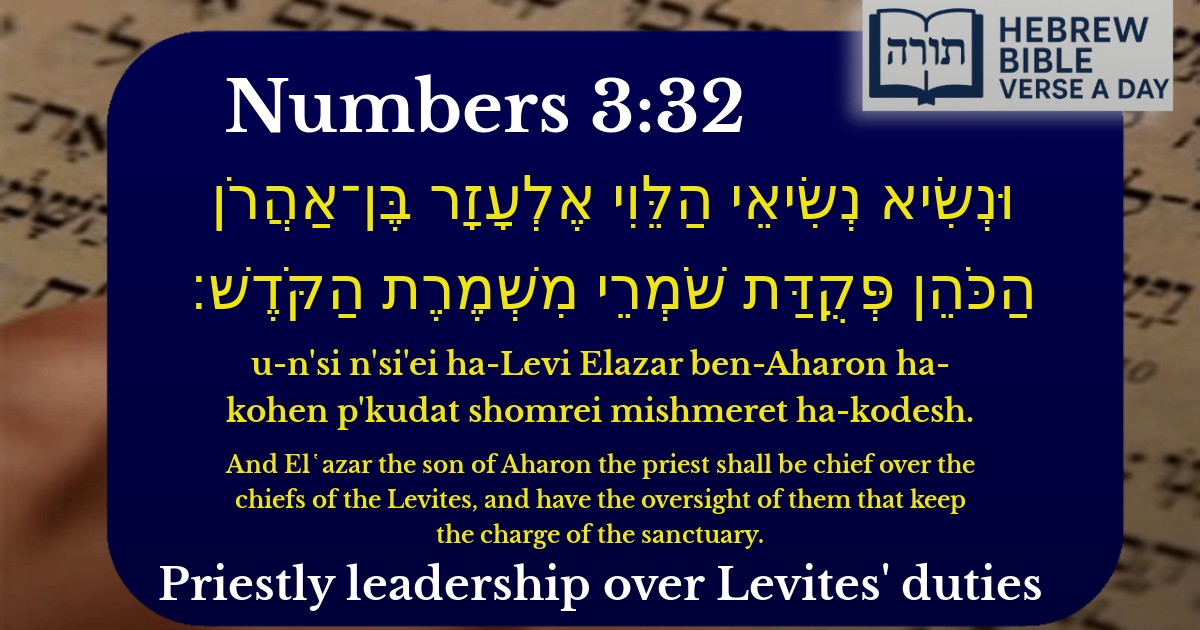Frequently Asked Questions
Q: Who was Elazar in the Torah?
A: Elazar was the son of Aharon the High Priest and served as a chief leader of the Levites. He was responsible for overseeing those who guarded the sacred duties of the Mishkan (Tabernacle), as mentioned in Numbers 3:32. According to Rashi, his role was crucial in maintaining the holiness and order of the sanctuary.
Q: What was the role of the Levites in the Mishkan?
A: The Levites were assigned to assist the Kohanim (priests) in the service of the Mishkan. Their duties included guarding, transporting, and maintaining the sacred vessels. Numbers 3:32 highlights that Elazar, as a leader, supervised these responsibilities to ensure everything was done properly, as explained in the Talmud (Arachin 11b).
Q: Why was Elazar given special leadership over the Levites?
A: Elazar was chosen because of his lineage as Aharon’s son and his personal righteousness. The Midrash (Bamidbar Rabbah 3:12) teaches that leadership in Judaism is based on both merit and divine appointment. His role ensured that the Levites fulfilled their duties with proper reverence for the Mishkan.
Q: What can we learn from Elazar’s leadership role today?
A: Elazar’s responsibility teaches the importance of appointing trustworthy leaders to oversee sacred matters. The Rambam (Hilchot Klei HaMikdash 3:8) derives from this that Jewish communal roles should be given to those with wisdom and integrity, ensuring that holy tasks are performed correctly.
Q: What does 'keeping the charge of the sanctuary' mean?
A: This phrase refers to safeguarding the Mishkan’s holiness by ensuring proper conduct in its service. Rashi explains that it included preventing unauthorized access and maintaining ritual purity. The Talmud (Zevachim 17a) elaborates that the Levites’ vigilance protected the sanctity of the Mishkan.


Elazar's Leadership Role
The verse (Bamidbar 3:32) establishes Elazar ben Aharon as the chief overseer of the Levites, specifically regarding the sacred duties of the Mishkan. Rashi explains that Elazar was appointed to supervise the work of the Kehat family, who carried the most sacred vessels (such as the Aron and Mizbe'ach). This elevated position reflects his unique status as both a Kohen and the son of Aharon HaKohen.
Hierarchy Among the Levites
Rambam (Hilchot Klei HaMikdash 3:8) elaborates that while the Levi'im were divided into three families (Gershon, Kehat, and Merari), Elazar held supreme authority over all their leaders. The Sforno adds that this structure ensured proper coordination in transporting the Mishkan, with Elazar ensuring each group fulfilled its specific responsibilities according to Divine command.
The Term "Nesi Nesi'ei HaLevi'im"
The double title "Nesi Nesi'ei HaLevi'im" (chief of the chiefs of the Levites) is analyzed in Midrash Tanchuma (Bamidbar 6): The first "Nesi" denotes his general leadership, while the second emphasizes his direct oversight of the Kehatites, whose duties involved the holiest objects. The Malbim further notes that this phrasing distinguishes Elazar's permanent role from the temporary assignments of other Levite leaders.
Connection to Mishmeret HaKodesh